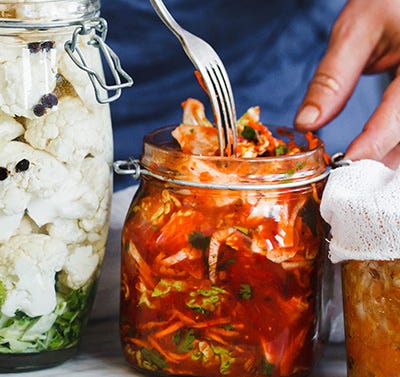Ingredient spotlight: prebiotics, probiotics and postbiotics
Ingredient spotlight: prebiotics, probiotics and postbiotics
With the emerging research of the human microbiome and the gut-skin connection, a language has evolved in the world of skin-friendly bacteria, which can lead to confusion. There are three categories of “positive” biotics, which you may have heard of: prebiotics, probiotics and postbiotics. These terms are something we should all understand, especially if you’re looking at ways to take care of your gut. So, what exactly are they and where can we find them? Our team of skin researchers define each one, identify the benefits and recommend the best sources for gut health and skin radiance.
Probiotics - "the workers"
Probiotics are live beneficial bacteria renowned to support gut health and their benefits have been spotlighted by scientists in recent years. Various probiotics has been found to address different health and skin concerns, so choosing the right types is key. The key benefit of probiotics is their ability to address digestive symptoms including bloating, constipation, and diarrhoea.² Increasing research, also shows that probiotics can help skin concerns including eczema, dry, ageing skin, and damage from UV rays. Specific probiotics have shown to increase the skin’s production of ceramides that assists the bacteria that keeps acne at bay ³ . Some excellent sources of probiotics are fermented foods which are full of flavour and can be added to a variety of different dishes.
Probiotic foods:
- Kimchi
- Sauerkraut
- Tempeh
- Miso
- Yoghurt with live cultures

Prebiotics - "the fuel"
Prebiotics are nutrients that are digested by the gut microbiome. They are referred to as food or fuel for the probiotics and consist of non-digestible fibre that promotes the growth of a healthy gut environment. We as humans can’t digest the fibre but our gut microbiome can. These types of fibre provide healthy nutrients to the gut microbiome to help support digestion and immune function. Furthermore, there has been increasing research that prebiotics can support specific skin concerns such as rosacea and acne, which are characterised by an impaired skin barrier.¹
The good news is food sources of prebiotics can easily be added to your weekly diet. Our team of researchers recommend adding the following high fibre foods and spices:
Prebiotics foods
- Legumes
- Beans
- Peas
- Asparagus
- Bananas
- Berries
- Garlic
- Onions
- Ginger
- Fennel

Postbiotics – "the products"
Postbiotics are bioactive compounds made by probiotics. Our beneficial bacteria digest vegetable fibre and produce nutrients such as vitamin K and B vitamins. Research shows postbiotics can support immunity and digestion, decrease inflammation, and benefit skin health ⁴.
So, an analogy would be the bees are the probiotics working in the hive. Pollen is like a prebiotic that the bees use to make honey, which is like a postbiotic.
So, what have we learnt? Evidence shows that prebiotics, probiotics and postbiotics all come with an array of benefits from digestion and immunity to supporting common skin concerns including rosacea, acne, ageing and dry skin. So, to reap some of these benefits, we recommend you consume foods that are high in fibre such as legumes, beans, peas, asparagus, berries, garlic, and onions. As well as fermented foods kimchi, sauerkraut tempeh and miso for gut health and skin radiance.
Sources:
¹ Prebiotics: Definition, types, sources, mechanisms and clinical applications. National Library of Medicine. .D, Davari, M,Negahdaripour, I Karimzadeh, M Seifan, M Mohkam, S Masoumi, A Berenjian, YGhasemi. March 2019.
² Probiotics for the Prevention of Antibiotic-Associated Diarrhea in Outpatients—A Systematic Review and Meta analysis. National Library of Medicine. C Butler. October 2017.
³ Functional role of probitoics and prebiotics on skin health and disease. Multidisciplinary Digital Publishing Institute. V Lolou, M Panayiotidis. May 2019.
⁴ Postbiotics – A step beyond pre-and probiotics. National Library of Medicine. J Zolkiewicz, A Marzec, M Ruszcynski, W Feleszko, July 2020.

